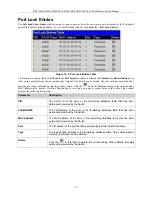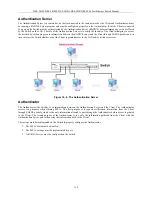
DES-3010F/DES-3010FL/DES-3010G/DES-3018/DES-3026 Fast Ethernet Switch Manual
Understanding 802.1x Port-based and MAC-based Network
Access Control
The original intent behind the development of 802.1X was to leverage the characteristics of point-to-point in LANs. As any
single LAN segment in such infrastructures has no more than two devices attached to it, one of which is a Bridge Port.
The Bridge Port detects events that indicate the attachment of an active device at the remote end of the link, or an active
device becoming inactive. These events can be used to control the authorization state of the Port and initiate the process of
authenticating the attached device if the Port is unauthorized. This is the Port-Based Network Access Control.
Port-Based Network Access Control
…
802.1X
Client
802.1X
Client
802.1X
Client
802.1X
Client
802.1X
Client
802.1X
Client
802.1X
Client
802.1X
Client
802.1X
Client
Network access controlled port
Network access uncontrolled port
RADIUS
Server
Ethernet Switch
Figure 10- 10. Example of Typical Port-Based Configuration
Once the connected device has successfully been authenticated, the Port then becomes Authorized, and all subsequent
traffic on the Port is not subject to access control restriction until an event occurs that causes the Port to become
Unauthorized. Hence, if the Port is actually connected to a shared media LAN segment with more than one attached
device, successfully authenticating one of the attached devices effectively provides access to the LAN for all devices on the
shared segment. Clearly, the security offered in this situation is open to attack.
122
















































